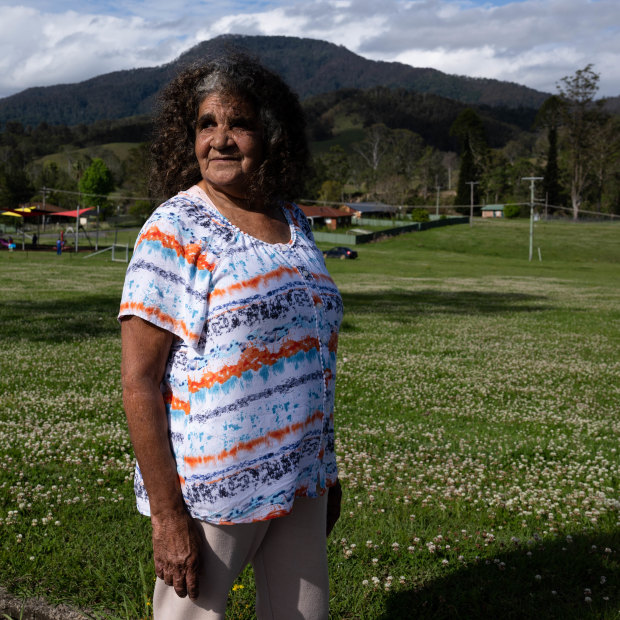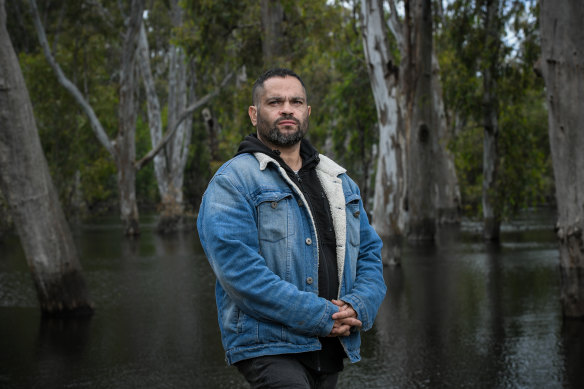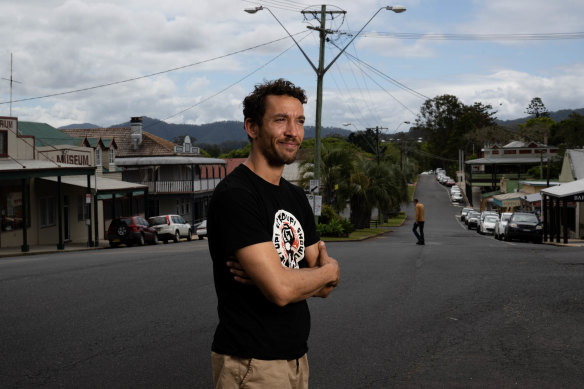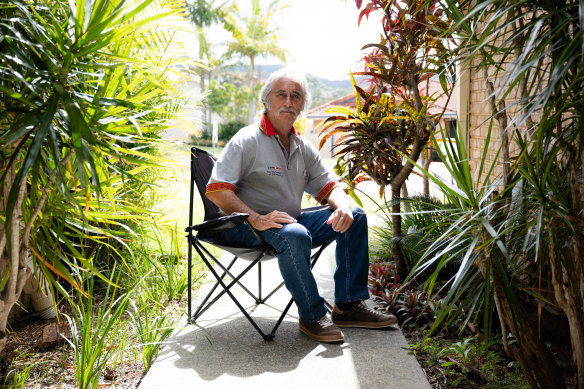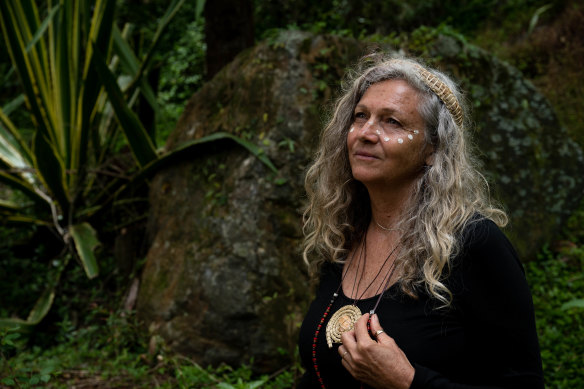Raising Indigenous voices on a Voice to parliament
By Caitlin Fitzsimmons and Jack Latimore
Thunggutti elder Aunty Ruth Dunn in Bellbrook on the NSW Mid North Coast.Credit:Janie Barrett
When Aunty Ruth Dunn was a child, she lived under the rule of an Aboriginal mission manager who controlled most aspects of everyday life.
The days of the mission manager are long gone, it has been 15 years since the Rudd government apologised for the stolen generations, and Dunn’s people now have control over some of their ancestral lands.
But Dunn says her people are still not heard in Australia’s corridors of power – and she hopes a First Nations Voice to parliament can change that.
“We are the voice of our elders who have passed on and didn’t have a voice at the time,” Dunn says.
“We’re the last to be heard, the last to be counted. We don’t want to be the last any more; we want to be equal …
“We need a Voice to represent our people and our culture and our nation. Being First Nations people, we’re the last to be heard, the last to be counted. We don’t want to be the last any more; we want to be equal to all the other cultures in the world and even to white Australians.”
At 67, Dunn still lives in the same community near Bellbrook, in the mountains above Kempsey on the NSW Mid North Coast. The elder welcomed our reporter and photographer to Thunggutti Country, which extends west towards Armidale and east down to the coast.
Bellbrook was just one stop in a national project involving journalists from The Sydney Morning Herald, The Age, WA Today and First Nations Media Australia from October to December last year.
We spoke to dozens of Indigenous people from all walks of life in capital cities, country towns and remote communities, from Townsville to Tasmania, and Broome to Adelaide. The conversations took place before the current campaign by Opposition Leader Peter Dutton to demand the Albanese government release draft legislation before a referendum on enshrining a Voice in the Constitution.
The goal was to go beyond the political debate in Canberra to better understand the opinions, concerns and questions of ordinary Indigenous Australians about the proposed Voice to parliament ahead of the referendum for constitutional change expected later this year.
At the political level, the voices of two key sceptical Indigenous leaders, Country Liberals senator Jacinta Nampijinpa Price and Greens senator Lidia Thorpe, have been influential, while academic Marcia Langton, lawyer Megan Davis and activist Noel Pearson have been important Aboriginal proponents of the idea.
Among the ordinary Indigenous people who shared their views with us, most said they would vote yes, some with enthusiasm and others with more cautious optimism. Some said no, citing suspicion, or doubts about how constitutional change would affect Aboriginal sovereignty. Many were undecided. And nearly everyone had questions.
Anthony Hume, 42, a Yorta Yorta man from Torquay in Victoria, was typical of the Voice supporters. “It is about time that we had a voice, so it is a definite yes from me that’s for sure,” he says.
Barry Smith, 51, a Noongar-Ballardong man from Midland, Western Australia, said: “I come from a country town where we don’t really have a say in much. I would really like to have someone who is representing us.”
Only a few people were in the definite no camp, but Kim Bramble, 52, a Biripi woman in Wauchope in NSW, was typical in saying the proposed Voice did not go far enough.
“I would absolutely vote no, and I think we are about 10 years away from being mature enough in our cultural journey to even have this dialogue,” Bramble says.
We own this country, and it was taken, so I don’t like to compromise.
“We own this country, and it was taken, so I don’t like to compromise. In conceding to the Voice, in some ways, what we give away is not fair on our future generations who may hate us for that.”
Ros Sailor, a Kuku Yalanji and Waanyi woman from Townsville, said she was presently “sitting on the fence” because she did not know enough about the plannned Voice to make an informed decision.
Rodney Gibbins, a palawa man from Hobart, was also in the undecided camp, saying he didn’t understand the proposal.
“We know it’s not going to have any power, we know it’s not going to have any say over funding or anything like that, so one has to wonder what’s the purpose of it?” Gibbins says.
Seeking more information
The proposed referendum is a national vote that will most significantly affect First Nations people. Electoral mathematics mean the outcome will not be determined by the 3.4 per cent of the population who identify as Indigenous. But non-Indigenous voters should hear Indigenous voices to understand what a Voice to Parliament means to First Nations people.
Josh Gilbert, a 31-year-old Worimi man from Gloucester in the Hunter Valley and the Indigenous co-chair of Reconciliation NSW, said there was “an extreme amount of goodwill from non-Indigenous people” that would inform the way people vote.
Last year Resolve Political Monitor asked voters their views on the exact wording of the Voice proposal aired by Prime Minister Anthony Albanese in July, and found almost two out of every three Australians would support it at a referendum. Other polls have drawn the same conclusion.
Equivalent polling of Indigenous Australians is difficult to come by. Our small but diverse sample suggests support is similarly high. Among those interviewed, more than half said they would vote yes, a third were unsure, and a handful were firmly in the no camp. (Not all were interviewed on video).
We spoke to men and women, young people and elders, people who are politically engaged, and people who say the only “Voice” they know of is the singing competition on television. There did not seem to be a consistent pattern, except that people who considered themselves well-informed were more likely to have a strong opinion.
A common sentiment from those surveyed was that not enough information was readily available. Jennifer Hubert, a Yindjibarndi woman living in Alice Springs, felt as though the information was “all there but it’s under the carpet, and it needs to come out more”.
Christopher Cooper, 43, a Yorta Yorta man from Echuca in Victoria and the chairperson of Yorta Yorta Nation Aboriginal Corporation, says he would probably vote no if the referendum were held right now.
Christopher Cooper in Echuca.Credit:Justin McManus
“It comes down to information – there’s not really a lot of knowledge and understanding around the direction of these type of things,” Cooper says. “I feel one of the key factors is to make sure you have informed your community and your mob around important decisions and issues around the self-determination of Aboriginal people.”
Edwina Shaw, 68, a pakana woman originally from Cape Barren Island in Tasmania, says the federal government has not done enough to raise awareness in all states and territories.
“The elder community that I mix with in Tassie here at home – we don’t have discussions on the Voice,” Shaw says. “It’s not an issue that we’ve talked about because it’s not an issue that’s been raised around our kitchen tables.”
Jordja Duroux, 20, a Gumbaynggir-Gamilaroi woman from Nambucca Heads in northern NSW, says she often discusses news and current affairs at home with her mother, but the Voice has never come up.
What powers would the Voice have?
There are 11 federal parliamentarians – three members of the House of Representatives and eight senators – who identify as Indigenous. Their divergent positions on the Voice reflect the fact there is also a range of views among First Nations people on the issue.
Kishaya Delaney, 26, a Wiradjuri woman from Orange in the NSW Central West who lives in Sydney, says this should not be a surprise.
“Obviously, there’s a diversity of opinions among First Nations people – we’re not a monolith and everyone has their own opinion,” she says.
Delaney, a member of Uluru Youth Dialogue, is firmly in favour of the Voice because she believes Aboriginal people should have input into laws that will affect them. Her biggest fear is that the amount of misinformation already out there could sink the referendum.
Based on interviews by this masthead, opposition to the Voice seems to fall into a few main categories: whether there are more pressing issues; whether it will go far enough; and whether it will impinge Indigenous sovereignty.
Some voiced scepticism about whether the Voice would actually improve their lives – echoing criticism by the likes of Nampijinpa Price, who identifies as Warlpiri-Celtic and drove the National Party’s decision to formally oppose the referendum.
Monica Morgan, 67, a Yorta Yorta woman from Echuca in Victoria, said: “My question for the Voice is: what is it going to deliver to sovereign First Nations people on the ground? What is it going to do that other voices in the past hadn’t?”
Thomas Stanbrook, a Gumbaynggirr man, in Bowraville, NSW.Credit:Janie Barrett
Thomas Stanbrook, 32, a Gumbaynggirr man from Bowraville on the Mid North Coast of NSW, said he was “not keen on an advisory panel with no real powers” and he was also concerned about creating a bureaucratic structure that gave power to some members of the community over others.
“There is a divide within Indigenous communities … it would be a concern, if that were to continue or be made worse by having a Voice,” Stanbrook said.
Deborah Briggs, a Gomeroi woman from Narrabri in western NSW, summed up the sovereignty argument when she said she refused to be part of a government that was “still today taking kids from the hands of our mothers and trying to integrate them”.
“Nobody has come to me to ask if I want to hand over my sovereign rights and my allodial title over Country, nor would I allow them to,” Briggs said. “I don’t aspire to be an Indigenous Australian, I only aspire to be Gomeroi.”
The Uluru Statement from the Heart, issued in 2017 after the National Constitutional Convention, called for constitutional reforms “to empower our people and take a rightful place in our own country”.
As well as the call for an Indigenous Voice enshrined in the Constitution, the gathering of more than 250 Indigenous community representatives also recommended a process of agreement making between governments and First Nations people, and truth-telling about history. The three pillars are summarised as Voice, Treaty, Truth.
Lidia Thorpe, a DjabWurrung Gunnai Gunditjmara woman from Melbourne and the Greens’ Indigenous affairs spokeswoman, is among those to raise concerns about sovereignty. While it is Greens policy to support the Voice, Thorpe has, at times, spoken against it, and she believes a treaty between the Commonwealth and First Nations people should be the priority.
Legal scholars say the Voice cannot extinguish sovereignty but a treaty can. Uluru Dialogue co-chair Professor Megan Davis, a constitutional lawyer and Cobble Cobble woman from south-east Queensland, says Indigenous sovereignty co-exists with the Crown.
Since neither federation in 1901 nor the referendum in 1967 ceded Indigenous sovereignty, nor would a Voice to Parliament.
“Giving up your sovereignty to another entity can’t be done through the Australian Constitution because the Constitution is an order that’s been imposed upon our people, and we haven’t ceded sovereignty to that order,” Davis says.
“No one can cede sovereignty other than yourself or your people, your tribe, your nation.”
When it comes to treaty-making, she says, it is possible to either give up sovereignty in the process or for two sovereign entities to continue to co-exist as they do now.
A need to be understood
We also encountered many Indigenous people who would vote for a Voice to Parliament on principle, but with tempered enthusiasm.
John Heath, 71, a Biripi man who lives in Bonny Hills, said the Voice would not redress the oppression and illegal acquisition of land since white settlement.
John Heath in his Bonny Hills home on the NSW Mid North Coast.Credit:Janie Barrett
“I would vote yes because it’s a step forward, as long as it’s understood it does not exclude further steps,” Heath said.
Similarly, Paul Callaghan, 62, a Worimi man who lives in Old Bar on the NSW Mid North Coast, said the Voice “sounds like a good thing” and he can’t see any problems with it being fast-tracked, but noted it would achieve only so much.
“We do need a voice but, more importantly, we need to be heard,” Callaghan said. “And even more important than being heard, is we need to be understood, and then action [must be] taken based on what we’ve shared. I still have a big question about how that happens.”
Most of the people who were yet to decide their position were awaiting further detail.
Aunty Rhonda Radley, 63, a Birpai elder from Port Macquarie, said she wanted to listen to both sides of the argument before finalising her position, saying she felt there had not been enough “open discussion”.
Aunty Rhonda Radley.Credit:Janie Barrett
The Albanese government wants the referendum question to be about broad, in-principle agreement. If the proposal is supported by the vote, the government would design the Voice in consultation with the community and legislate in parliament.
Indigenous Australians Minister Linda Burney says: “A vote for yes in 2023 will be a vote for improving the lives of Aboriginal and Torres Strait Islander Australians by giving communities a say.”
It is clear many ordinary voters want to know more about what is proposed. Dutton has criticised the government for treating the Australian public “like mugs” over the lack of detail ahead of a vote. He has demanded Labor release draft legislation before the referendum. In response, Attorney-General Mark Dreyfus accused Dutton of “talking out of both sides of his mouth” and challenged him to make his position clear on the Voice.
Proponents of the Voice point out if the Voice passes the in-principle agreement of a referendum, parliament will still have to pass legislation to establish a specific model, providing plenty of opportunity for democratic debate on the detail.
Burney says a referendum working group has already outlined key design principles, including that the Voice be independent, accountable and transparent, with representatives chosen by First Nations communities, and without a veto or the ability to administer programs.
Davis says it would be a disaster for the Constitution to embed a fully fledged model because then any changes would also require a referendum.
“The model of 2022 is probably not going to match the model of 2052,” she says. “You need agility in the system.”
For Harry Brandy, 75, a Bundjalung man in Harrington on the NSW Mid North Coast and a former public servant, the Voice is a no-brainer, and the demand for detail is a familiar one.
“I remember the 1967 referendum clearly and a lot of people were unsure because there wasn’t enough information,” Brandy says.
“I believe that a referendum, if it was done properly, organised properly, and the people believed in it, would be a great thing.”
Additional reporting: Rebecca Peppiatt and Holly Thompson (WAtoday), Jillian Mundy, Patrick McKenzie and Velma Gara (First Nations Media Australia) and Eelemarni Close-Brown.
Fascinating answers to perplexing questions delivered to your inbox every week. Sign up to get our Explainer newsletter here.
Most Viewed in National
Source: Read Full Article
